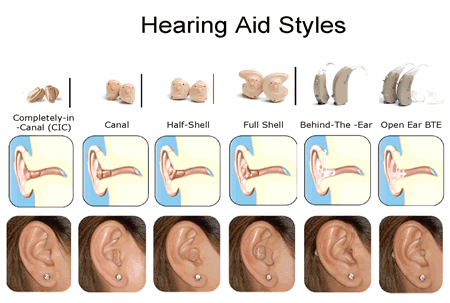What is the difference between the available types of hearing aids?
- Posted on: Feb 11 2014
Guest blogger: Peter Fan, AuD
For many people, hearing loss is a natural part of the aging process, and the onset is so gradual they aren’t aware their hearing is deteriorating. Hearing loss can also be caused by genetic and/or medical conditions, ear infections, illness, traumatic injury or prolonged exposure to noise.
Hearing loss is one the world’s most common health problems. It is also one of the most ignored problems. This is unfortunate because hearing loss and its psychological side effects are highly treatable. Hearing loss is not like listening to sounds with the volume turned down. Instead, you may notice that certain spoken sounds, such as “sh,””th” and “f,” are more difficult to hear than others. That’s why people with hearing loss often say they can hear people taking but can’t understand what is being said.
While most hearing losses do not cause physical pain, they often have social and psychological affects. These include: breakdown of communication, social isolation, depression, frustration and loss of self-esteem. Untreated hearing loss in children can delay the development of speech, language and learning skills. Signs of hearing loss may include:
- People seem to mumble
- Asking others to repeat themselves
- Difficulty following conversations when the background is noisy or when in group situations
- Children’s and women’s voices are difficult to hear
- Being able to hear people talk, but having difficulty understanding the words
- The TV or radio are turned up louder than normal
- High pitched sounds such as birds, crickets and bells cannot be heard
- Family, colleagues and friends suggest you might have a hearing problem
- You often hear a ringing or buzzing in your ears.
It’s important to know you’re not alone. Approximately one in 10 people experience some degree of hearing loss and about 90% of these people can be helped with the use of hearing instruments. Choosing the right hearing instruments comes down to a number of factors: your hearing loss, the features and look you prefer and your lifestyle.
- Degree of hearing loss: Not all styles and technologies are appropriate for all hearing losses. Usually greater the hearing loss, bigger the size of hearing instrument you will need.
- Ear anatomy: Some ear canals are very tiny, making it almost impossible to fit a completely-in-the-canal style (CIC).
- Lifestyle: Your different listening environments will help dictate the best hearing instrument to meet your needs.
- Design preference and budget: Choose from a wide variety of styles, colors and sizes at a wide range of prices to fit every budget.
Variety of hearing instrument styles.
- Complete-in-the-canal (CIC) fits deep inside your ear canal, making it almost invisible. For mild to moderately severe hearing losses.
- In-the-canal (ITC) fits almost entirely inside your ear canal. The slight size increase allows the ITC to accommodate options that may not fir on a CIC. For mild to moderately severe hearing losses.
- In-the-ear (ITE) fits securely in your outer ear and provides sufficient space for extra options. For mild to severe hearing losses.
- Behind-the-ear (BTE) sits comfortably behind your ear, with sounds passing through a tube to an ear mold that fits in your outer ear. For mild to profound hearing losses.
- Receiver-in-the-canal (RIC) provides an open fit (meaning nothing plugs your ear canal) and natural sounds via a discreet slim wire which directs sound into the ear. For mild to severe hearing losses.
Hearing instrument technology has undergone huge advances, providing sophisticated hearing solutions that meet the demands of active lifestyles. Today hearing instruments are much smaller-some are virtually invisible- and some are able to integrate seamlessly with other technologies, such as Bluetooth-enabled cell phones and MP3 players.
If you think you have a hearing loss, you should talk to an audiologist. Audiologists are trained to identify, treat and prevent hearing loss. During the evaluation, your audiologist will determine the degree of your hearing loss, discuss the results with you, explain your hearing condition, refer you to a physician (if necessary) and select and fit your hearing instruments. These hearing instruments are usually covered by a 30-day adjustment period, giving you time to get used to them and your audiologist an opportunity to fine tune them, if needed.
Tagged with: ear nose throat, ENT, hearing aid, hearing aids, hearing loss, Isaac Namdar, Isaac Namdar MD, nerve loss, New York, new york city, Otolaryngology, Otorhinolaryngology, Peter Fan AuD, presbycusis, sensorineural hearing loss
Posted in: Ears


